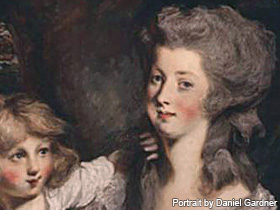John Andr??; Benedict Arnold; Edward Shippen; Margaret Shippen; Revolutionary War; spy; traitor
Margaret (Peggy) Shippen was born in 1760 in Philadelphia, Pennsylvania. She was the third daughter of a very prominent family and a determined political woman. Her life was destined for wealth and success, until she met her husband Benedict Arnold, a relationship that led her into a life of infamy.
Margaret "Peggy" Shippen was born Margaret Shippen on July 11, 1760, to one of the most prominent families in Philadelphia, Pennsylvania. Her mother was Margaret Shippen, who was the daughter of the prominent lawyer, Tench Francis, and her father was Edward Shippen IV, who was the grandson of the first mayor in Philadelphia and the founder of Princeton University. Her father is best known as being an admiralty judge and a member of Pennsylvania's Provincial Council and the Pennsylvania Supreme Council. She had three sisters: Sarah, Elizabeth, and Mary, and three brothers: Edward, John Francis and James. Altogether, the Shippens were a well-known loyalist family during the Revolutionary Movement. As a young girl, Peggy enjoyed learning music, drawing, and needlework. However, her main interests were newspapers and political jargon. She lovingly admired her father, and she learned about politics and the Revolution from him. Because they were from a prosperous family, Peggy and her sisters were often invited to many social gatherings and special events.
At one of these gatherings after the British took control of Philadelphia, Peggy met Major John André, an officer under the command of General Howe. He became a regular acquaintance of the Shippen household and favored Peggy among the girls. In 1778, André invited Peggy to a masquerade ball in tribute to the end of General Howe's command. Her father, who was convinced by local authorities that the event would be disgraceful, did not allow the Shippen girls to attend the ball. Peggy was traumatized when her father restricted her attendance, but the tantrums faded when she realized the dishonor it would bring to the family. Soon after the event, André and his troops left the city of Philadelphia, but Peggy stayed in contact with him. Shortly after André's departure, Peggy Shippen became acquainted with Benedict Arnold, the recently established American Military Governor of Philadelphia. After the marriage of Elizabeth Shippen, Arnold sent Peggy's father a letter to propose an engagement. Mr. Shippen did not take the matter lightly. He was not fond of Arnold because he had heard of the recent charges held against the general due to his improper expenditure on his own behalf. Nevertheless, Mr. Shippen eventually consented to the engagement, and on April 8, 1779, 37-year-old Arnold married 19-year-old Peggy. After hearing the charges brought against Arnold, citizens began to view the couple as suspicious.
Peggy and Arnold had many close associations with members of the Tory party. During this time, Peggy was also keeping in contact with Major André, and she may have revealed valuable military secrets to the British. Simultaneously, Arnold was making secret negotiations with the enemy. Shortly after, Arnold was relocated to West Point, which was the most crucial fort to the Continental Army, and Peggy followed. Through contact with the enemy, Arnold wrote letters to General André that exposed the military strength of the American army and their future defensive plans. In Benedict Arnold: A Traitor in our Midst, Barry Wilson said, "Peggy had a Tory outlook and high-level British and Loyalist contacts, which Arnold later used. This has led some Americans to insist that she was behind Arnold's later treason." Peggy knew about and possibly fostered Arnold's plot. Needless to say, Washington retrieved other incriminating papers after capturing André and sought to punish Arnold for treachery. Arnold had previously fled, leaving Peggy alone with a newly born child. Peggy returned to Philadelphia to stay with her family, but she was banned from the city on October 20, 1780. She then went to join him in New York . Shortly afterwards, they relocated to England. She became very unhappy because people treated her differently. In The Traitor and the Spy, James Thomas Flexner said, "Peggy saw 'ruin staring her in the face,' her 'agonizing state of mind' made a further drain on her husband." On June 14, 1801, Benedict Arnold died, being infamously remembered as a traitor and a spy. His death left Peggy having to cope with their bad name and settle Many debts. Three years later, on August 24, 1804, Peggy Arnold died from cancer, and her suspenseful and tragic life came to an end. She left behind four sons, three of whom were in the military, and a daughter named Margaret.
- Carson, B.F. "Whom Can We Trust Now" The Meaning of Treason in the United States, from the Revolution through the Civil War. Lanham, MD: Rowan & Littlefield, 2006. 139-141.
- Flexner, James Thomas. The Traitor and the Spy: Benedict Arnold and John Andre. Boston, MA: Little, Brown & Company, 1975. 186-492.
- Klein, Randolph S. Portrait of an Early American Family. Philadelphia, PA: University of Pennsylvania P, 1975. 153-311.
- Morgan, Barbara. Shippen, Peggy (1760—1804). Women in World History: A Biographical Encyclopedia. Ed. Anne Commire. Vol. 14. Detroit: Yorkin Publications, 2002. 272-274. Gale Virtual Reference Library. Web. 24 Sep. 2011.
- Murphy, Jim. The Real Benedict Arnold. New York: Houghton Mifflin Company, 2007. 4-224.
- Rinaldi, Ann. Finishing Becca: a Story About Peggy Shippen and Benedict Arnold. New York, NY: Harcourt Brace & Company, 1994. 211-289.
- Tillotson, Harry S. The Exquisite Exile: the Life and Fortunes of Mrs. Benedict Arnold. Boston, MA: Lothrop, Lee & Shepard Co., 1932.
- Wilson, Barry K. Benedict Arnold: A Traitor in Our Midst. Ithaca, NY: McGill-Queen's University Press, 2001.
Daughter of a wealthy Philadelphia merchant, Peggy Shippen married Benedict Arnold.

